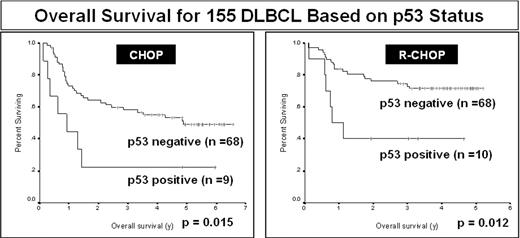Abstract
Background: The addition of rituximab to CHOP (CHOP-R) chemotherapy has resulted in an improved outcome for patients with DLBCL and has recently been shown to diminish the prognostic impact of two recognized biomarkers, namely Bcl-2 and Bcl-6. In the CHOP era, p53 mutations in DLBCL were associated with an aggressive clinical course and shortened survival. Using immunohistochemistry and mutational analysis, p53 over-expression and mutational status were examined in a population-based cohort of DLBCL patients treated with CHOP or CHOP-R (
Method: We analyzed 155 patients from a total cohort of 292 patients based on available paraffin blocks with sufficient tissue for interpretable immunohistochemistry for all antigens. All were initial diagnostic biopsies of de novo DLBCL cases accrued between 1999 and 2002 at the BCCA. HIV+ patients or those with active secondary malignancies were excluded. Tissue microarrays (TMA) were built using duplicate 0.6mm cores from paraffin embedded formalin fixed (FFPE) diagnostic biopsies and stained with antibodies against CD10, Bcl-6, MUM1, Bcl-2, p53 and p21. DLBCL cases were assigned to GCB or non-GCB subgroups based on the method of Hans et al., Blood 103: 275–82 (2004). Strong nuclear expression of the p53 antibody (clone DO7) was defined as high intensity (3/3) expression in >50% of the malignant cells. The p53 gene mutational analysis was performed on this subset of cases with DNA extracted from FFPE samples using the AmpliChip™ p53 test (developed in Roche Molecular Systems, Inc.).
Results: Patients were treated with either CHOP (n = 77) or CHOP-R (n = 78). Their clinical characteristics, including the IPI factors, were evenly matched. The two treatment cohorts represent consecutive eras of therapy and thus the median follow-up of living patients was 5.1 and 4.0 y for CHOP vs CHOP-R, respectively. Of the 155 patients, 75 had a GCB phenotype and 80 non-GCB, with similar distribution in both treatment groups. There were 19 strong p53-positive cases (19/155 or 12.3%). Ten p53-positive cases were GCB and 9 were non-GCB. All 19 strong p53-positive cases were negative for p21 expression and 16/17 analyzable cases had p53 mutations. Univariate analysis of the entire cohort (n = 155) revealed that both IPI and p53 expression were of prognostic importance (p < 0.0001). In multivariate analysis, strong p53 and IPI were independent predictors of OS (p = 0.005 and p < 0.0001, respectively). Importantly, when analyzed by treatment era, strong p53 expression remained significant in both CHOP (p=0.015) and CHOP-R groups (p=0.012).
Conclusion: Strong p53 protein expression correlates with p53 mutations and is an independent prognostic factor for patients with DLBCL even when treated with CHOP-R. p53 mutations were found in both GCB and non-GCB subtypes. Importantly the prognostic impact of p53 is not diminished in the era of CHOP-R, identifying a subgroup of patients with inferior survival.
Overall Survival for 155 DLBCL Based on p53 Status
Disclosures: Basic science research support and fellowship support from Roche Canada.; Honoraria from Roche, Genitope, Berlex.; Ad boards for Lilly, Roche, Millenium, Biogen Idec.
Author notes
Corresponding author


This feature is available to Subscribers Only
Sign In or Create an Account Close Modal